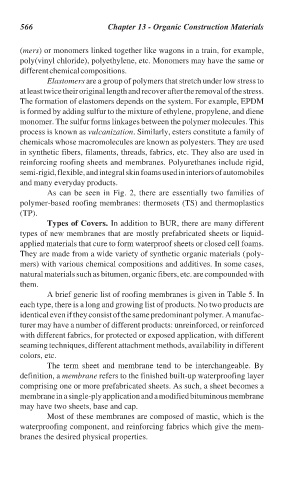Page 599 - Handbook of Thermal Analysis of Construction Materials
P. 599
566 Chapter 13 - Organic Construction Materials
(mers) or monomers linked together like wagons in a train, for example,
poly(vinyl chloride), polyethylene, etc. Monomers may have the same or
different chemical compositions.
Elastomers are a group of polymers that stretch under low stress to
at least twice their original length and recover after the removal of the stress.
The formation of elastomers depends on the system. For example, EPDM
is formed by adding sulfur to the mixture of ethylene, propylene, and diene
monomer. The sulfur forms linkages between the polymer molecules. This
process is known as vulcanization. Similarly, esters constitute a family of
chemicals whose macromolecules are known as polyesters. They are used
in synthetic fibers, filaments, threads, fabrics, etc. They also are used in
reinforcing roofing sheets and membranes. Polyurethanes include rigid,
semi-rigid, flexible, and integral skin foams used in interiors of automobiles
and many everyday products.
As can be seen in Fig. 2, there are essentially two families of
polymer-based roofing membranes: thermosets (TS) and thermoplastics
(TP).
Types of Covers. In addition to BUR, there are many different
types of new membranes that are mostly prefabricated sheets or liquid-
applied materials that cure to form waterproof sheets or closed cell foams.
They are made from a wide variety of synthetic organic materials (poly-
mers) with various chemical compositions and additives. In some cases,
natural materials such as bitumen, organic fibers, etc. are compounded with
them.
A brief generic list of roofing membranes is given in Table 5. In
each type, there is a long and growing list of products. No two products are
identical even if they consist of the same predominant polymer. A manufac-
turer may have a number of different products: unreinforced, or reinforced
with different fabrics, for protected or exposed application, with different
seaming techniques, different attachment methods, availability in different
colors, etc.
The term sheet and membrane tend to be interchangeable. By
definition, a membrane refers to the finished built-up waterproofing layer
comprising one or more prefabricated sheets. As such, a sheet becomes a
membrane in a single-ply application and a modified bituminous membrane
may have two sheets, base and cap.
Most of these membranes are composed of mastic, which is the
waterproofing component, and reinforcing fabrics which give the mem-
branes the desired physical properties.

